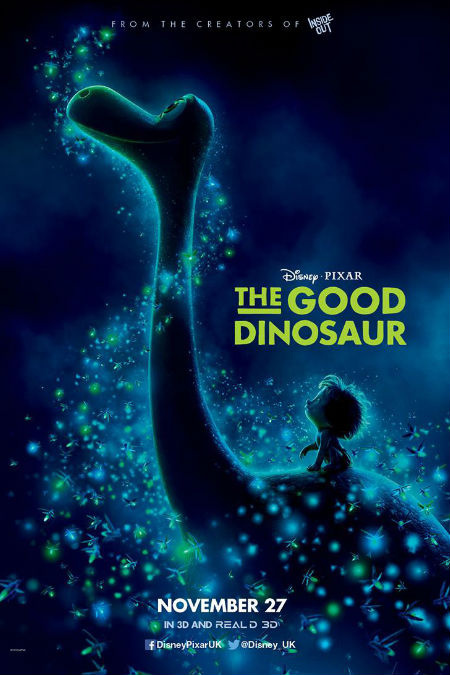
Being the curious creatures that we are, humanity has always loved a good “What if?” scenario.
It has fuelled the ragingly successful genre of alternate history, one that Pixar has now joined with gusto and its trademark insight into the “human” condition and emotional nuance.
Far from being the poorer cousin that had the “misfortune” to come out in the same year as one of the legendary animation studio’s most successful efforts yet, Inside Out, The Good Dinosaur is a deeply-affecting clever film, one that pivots on the idea that the meteor that destroyed much of the prehistoric life on Earth 65 million years ago never happened, leaving dinosaurs free to keep merrily evolving.
The result is an agrarian society where Apatosaurus, which includes the family of the endearing protagonist Arlo (Raymond Ochoa), are pioneer farmers carving out a hard but honest living, Tyrannosaurs are tough, well-worn but kindly ranchers herding irascible groups of prehistoric longhorns, and velociraptors, keeping with their image as the opportunistic “cowboys” of the very ancient world, are redneck smugglers, always keen to benefit from another dinosaurs work.
It’s a classic Western set-up, one that screenwriter Meg LeFauve, and director Peter Sohn, to perfect effect to create a world in which humanity, still stuck in the caves, and incapable of speech though bonded in fiercely-loving, protective family groups, are lagging way behind the dinosaurs.
In this brave new alternate world, a lost caveboy such as Spot (Jack Bright) is a “critter”, a pest that feeds off the stored grain of Arlo’s family – Poppa Henry (Jeffrey Wright), Momma Isa (Frances McDormand) and siblings Buck (Marcus Scribner) and Libby (Maleah Padilla) – who must be exterminated if the family is to survive the winter.
But young Arlo, the youngest and more timid of his siblings, is not as brave as the rest of his family, who have all made their mark – in this case, literally with each member stamping a footprint on to the tall hollow stone cairn which houses the corn they have harvested – after accomplishing something greater than themselves.
Arlo, afraid of the chickens in the coop, who frankly look like the love children of actual chickens and ZZ Top, and life in general, is afraid he might never come close to making his mark, with life providing plenty of opportunities to run the other way.
Then as is the way of these things, something unexpected happens and Arlo finds himself in close quarters a long way from his farm with Spot, so-named because he displays all the tenacity and affection of a devoted puppy, with the less-advanced human child coming to his dinosaur counterpart’s rescue on more than one occasion.
And there is quite a bit of rescuing to be done, with this alternate world every bit as challenging and dangerous as the one it supplanted, the world we live in now.
For all the allies that Arlo and Spot come across, including grizzled but fair Tyrannosaur ranchers Butch (Sam Elliott), Nash (A. J. Buckley) and Ramsey (Anna Paquin), there are a host of adversaries such as a loopy New Age Styracosaurus (Peter Sohn) who wants to add Spot to his cultish multi-horned dwelling menagerie, and deluded, messianic Nyctosaurus (Steve Zahn) who is convinced that the storms which regularly plague the landscape in which Arlo is now lost and far from home, are harbingers of plenty and the promise of a bountiful life to come.
That’s if you’re a cruel, duplicitous hungry flying reptile that is.
Together, bit by bit, Arlo and Spot discover they’re not so different after all, and they set about trying to get back to the former’s home where his family awaits and a world in which human and dinosaur may not be so far apart beckons.
What distinguishes The Good Dinosaur, and lends it far more substance and emotional impact than the trailers might suggest, is its willingness to inject a far darker tone than animated tales of protagonists trying with all their might to reach secure surroundings often possess.
It is every bit as impacting, despite its vastly different subject matter as Inside Out, daring us to own up to our fears (suppressing them gets you nowhere), face them and come through to what Arlo’s dad calls “the beauty on the other side”.
Arlo isn’t just faced with physical challenges but existential ones in which he is asked with force and vigour, and some lovely touches of nicely-positioned humour and collegially-warm moments, to choose the kind of dinosaur (read: person) he will be.
It’s hard to miss that The Good Dinosaur comes with a great, big moral but for all that, it’s never so heavy-handed as to become overbearing or mawkish.
The emotional payoff in the story, as it is with pretty much all the superlative Pixar efforts, is hard-won and meaningful, the result of a character going to figurative hell and back to find out who they really are, and what truly matters to them.
Set against stunningly beautiful photo-realistic backdrops, where water flows with power and beauty and a single grain stands in stark contrast to the stony ground on which it falls, The Good Dinosaur is a visual and emotional triumph.
Don’t think for a moment that Pixar has spent all of the intellectual and emotional capital devoted to its twin 2015 releases on Inside Out; brilliant though that film is, The Good Dinosaur is every bit its equal reminding us over and over that alternate world or not, we all have a need, dinosaur and human together, to make our mark, to feel as if our lives amount to something.
It’s a sage lesson that Pixar once again conveys with deep emotional resonance, stunning animation and intellectual brilliance in The Good Dinosaur, yet another worthy entry in the studio’s ever-growing stable of superlatively-realised, and always affecting, animated films.